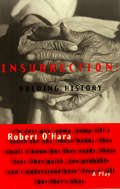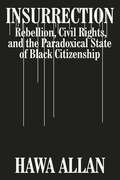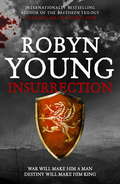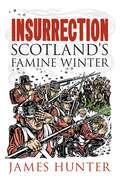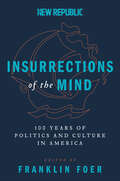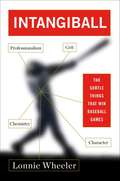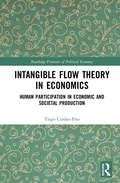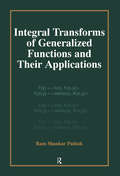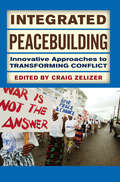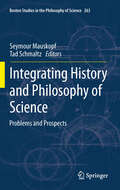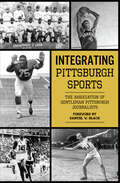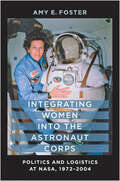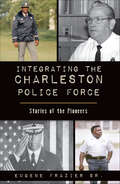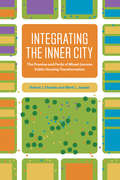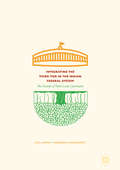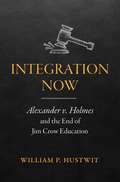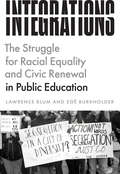- Table View
- List View
Insurrection: Holding History
by Robert O HaraThe first publication of Insurrection, a remarkable debut of a major new African-American theatre artist. The playwright won the distinguished Oppenheim Award from Newsday for best new playwright of 1997. Insurrection is a chilling exploration of the roots of the Nat Turner slave insurrection through the eyes of a contemporary black man who is transported back through time with his grandfather.
Insurrection: Rebellion, Civil Rights, And The Paradoxical State Of Black Citizenship
by Hawa AllanA brilliant debut by lawyer and critic Hawa Allan on the paradoxical state of black citizenship in the United States. The little-known and under-studied 1807 Insurrection Act was passed to give the president the ability to deploy federal military forces to fend off lawlessness and rebellion, but it soon became much more than the sum of its parts. Its power is integrally linked to the perceived threat of black American equity in what lawyer and critic Hawa Allan demonstrates is a dangerous paradox. While the Act was initially used to repress rebellion against slavery, during Reconstruction it was invoked by President Grant to quell white-supremacist uprisings in the South. During the civil rights movement, it enabled the protection of black students who attended previously segregated educational institutions. Most recently, the Insurrection Act has been the vehicle for presidents to call upon federal troops to suppress so-called “race riots” like those in Los Angeles in 1992, and for them to threaten to do so in other cases of racial justice activism. Yet when the US Capitol was stormed in January 2021, the impulse to restore law and order and counter insurrectionary threats to the republic lay dormant. Allan’s distinctly literary voice underscores her paradigm-shifting reflections on the presence of fear and silence in history and their shadowy impact on the law. Throughout, she draws revealing insight from her own experiences as one of the only black girls in her leafy Long Island suburb, as a black lawyer at a predominantly white firm during a visit from presidential candidate Barack Obama, and as a thinker about the use and misuse of appeals to law and order. Elegant and profound, deeply researched and intensely felt, Insurrection is necessary reading in our reckoning with structural racism, government power, and protest in the United States.
Insurrection: Robert The Bruce, Insurrection Trilogy Book 1 (Insurrection Trilogy #Bk. 3)
by Robyn YoungThe first book in the Insurrection trilogy, which tells the thrilling story of Robert the Bruce.1286 A.D. Scotland is in the grip of the worst winter in living memory. Some say the Day of Judgement has arrived.The King of Scotland rides out from Edinburgh into the stormy night. On the road he is murdered by one of his own men, leaving the succession to the throne wide open. Civil war threatens as the powerful Scottish families jostle for power, not knowing that King Edward I of England has set his own plans for conquest in motion.But all is not destined to go Edward's way. Through the ashes of war, through blood feuds and divided loyalties, a young squire will rise to defy England's greatest king. His name is Robert Bruce. Insurrection is the first in an addictive and action-packed trilogy in the tradition of Conn Iggulden, Bernard Cornwell and Manda Scott.
Insurrection: Robert The Bruce, Insurrection Trilogy Book 1 (Insurrection Trilogy)
by Robyn Young1286 A.D. Scotland is in the grip of the worst winter in living memory. Some say the Day of Judgement has arrived. The King of Scotland rides out from Edinburgh into the stormy night. On the road he is murdered by one of his own men, leaving the succession to the throne wide open. Civil war threatens as the powerful Scottish families jostle for power, not knowing that King Edward I of England has set his own plans for conquest in motion. But all is not destined to go Edward's way. Through the ashes of war, through blood feuds and divided loyalties, a young squire will rise to defy England's greatest king. His name is Robert Bruce. Insurrection is the first in an addictive and action-packed trilogy in the tradition of Conn Iggulden, Bernard Cornwell and Manda Scott.(P)2010 Hodder & Stoughton Audiobooks
Insurrection: Scotland's Famine Winter
by James HunterThe author of On the Other Side of Sorrow gives a detailed account of the causes and effects of the Scottish potato famine that began in 1846. When Scotland&’s 1846 potato crop was wiped out by blight, the country was plunged into crisis. In the Hebrides and the West Highlands, a huge relief effort came too late to prevent starvation and death. Farther east, meanwhile, towns and villages from Aberdeen to Wick and Thurso protested the cost of the oatmeal that replaced potatoes as the people&’s basic foodstuff. Oatmeal&’s soaring price was blamed on the export of grain by farmers and landlords cashing in on even higher prices elsewhere. As a bitter winter gripped and families feared a repeat of the calamitous famine then ravaging Ireland, grain carts were seized, ships boarded, harbors blockaded, a jail forced open, and the military confronted. The army fired on one set of rioters. Savage sentences were imposed on others. But crowds of thousands also gained key concessions. Above all they won cheaper food. Those dramatic events have long been ignored or forgotten. Now, in James Hunter, they have their historian. The story he tells is, by turns, moving, anger-making, and inspiring. In an era of food banks and growing poverty, it is also very timely.Praise for Insurrection&“Hunter never forgets that history is first of all narrative—and this book is rich in stories—or that is subject is the experience of individual men and women, creatures of flesh and blood, not abstractions. Insurrection is fascinating reading, both painful and uplifting.&” —Allan Massie, the Scotsman (UK)
Insurrections of the Mind: 100 Years of Politics and Culture in America
by Franklin FoerTo commemorate the 100th anniversary of The New Republic, an extraordinary anthology of essays culled from the archives of the acclaimed and influential magazineFounded by Herbert Croly and Walter Lippmann in 1914 to give voice to the growing progressive movement, The New Republic has charted and shaped the state of American liberalism, publishing many of the twentieth century’s most important thinkers.Insurrections of the Mind is an intellectual biography of this great American political tradition. In seventy essays, organized chronologically by decade, a stunning collection of writers explore the pivotal issues of modern America. Weighing in on the New Deal; America’s role in war; the rise and fall of communism; religion, race, and civil rights; the economy, terrorism, technology; and the women’s movement and gay rights, the essays in this outstanding volume speak to The New Republic’s breathtaking ambition and reach. Introducing each article, editor Franklin Foer provides colorful biographical sketches and amusing anecdotes from the magazine’s history. Bold and brilliant, Insurrections of the Mind is a celebration of a cultural, political, and intellectual institution that has stood the test of time.Contributors include: Virginia Woolf, Vladimir Nabokov, George Orwell, Graham Greene, Philip Roth, Pauline Kael, Michael Lewis, Zadie Smith, William Faulkner, Ralph Ellison, James Wolcott, D. H. Lawrence, John Maynard Keynes, Langston Hughes, John Updike, and Margaret Talbot.
Insólitas parejas: Doce historias auténticas de enamorados famosos
by Daniel Samper PizanoLas mejores historias de amor contadas por Daniel Samper Pizano e ilustradas por Matador. ¿Existe una fuerza más dominante que el poder, el dinero, la religión y la libertad? Sí: el amor# sobre todo adobado con el sexo. La Historia se encarga de demostrarlo con ejemplos de enamoramientos insólitos, y a veces múltiples, que han sostenido o derrumbado imperios, hecho felices o infelices a muchas personas y desatado o esclavizado la capacidad creativa de cientos de artistas. Este libro ofrece doce historias genuinas de amores potentes e insólitos que son, al mismo tiempo, fascinantes aventuras sentimentales. Entre ellas: # Lucrecia Borgia, la hija del Papa Alejandro VI, se casó varias veces pero su verdadero amor secreto fue un cardenal y poeta. # Karl Marx, padre del comunismo, tuvo un matrimonio feliz con la aristócrata Jenny de Westfalia# y un hijo con la niñera. # Madame Curie, genial científica polaca, se enamoró perdidamente, ya viuda y madura, de un profesor casado y menor que ella. # Sir Winston Churchill y Clementine Hozier formaron unapareja sólida, rara y feliz que resultó clave para vencer a Hitler en la Segunda Guerra Mundial. # El sabio Caldas padeció dudas sexuales y se casó con Manuela Barahona, una joven de Popayán que no conocía y que luego se liberó. # El nobel de literatura Albert Camus mantuvo hasta su muerte intensos amores con una gran actriz española. Su esposa lo sabía. # Tres poderosas mujeres, dos de ellas emperatrices, cambiaron la historia de China y del mundo. La tercera fue la siniestra esposa de Mao Zedong.
Intangiball: The Subtle Things That Win Baseball Games
by Lonnie WheelerA unique and refreshing ode to the “little things” that represent baseball’s heartbeat—the player who, in countless ways, makes other players better.Intangiball tracks the progress of the Cincinnati Reds through five years of culture change, beginning with the trades of decorated veterans Adam Dunn and Ken Griffey, Jr. It also draws liberally from such character-conscious clubs as the Atlanta Braves, St. Louis Cardinals, San Francisco Giants, New York Yankees, and Tampa Bay Rays. Author, sportswriter, and eternal fan of the game, Lonnie Wheeler systematically identifies the performance-enhancing qualities (PEQs) that together comprise the “communicable competitiveness” that he calls “teamship.” Intangiball is not designed to debunk Moneyball, but rather to sketch in what it left out: “What order is there to a baseball world in which a struggling rookie benefits not a bit from the encouraging words of the veteran who drapes his arm around the kid’s shoulders; in which Derek Jeter’s professionalism serves none but him; in which there is no reward for hustle, no edge for enthusiasm, no payoff for sacrifice; in which there is no place for the ambient contributions of David Eckstein, Marco Scutaro, or the aging, battered Scott Rolen; in which shared purpose serves no purpose?” Intangibles, as it turns out, not only ennoble the game; they help win it. And this is the book every fan must read.
Intangible Flow Theory in Economics: Human Participation in Economic and Societal Production (Routledge Frontiers of Political Economy)
by Tiago Cardao-PitoThe dominant economic explanations of the 20th century are not comprehensive enough to describe the complexity of economy and society and their reliance on the biosphere. Intangible Flow Theory in Economics: Human Participation in Economic and Societal Production outlines a new theory that challenges both economics and the relativism conveyed in social constructivism, poststructuralism and postmodernism. To mainstream economics and Marxism, monetary flows transform us humans into commodities. To this new theory, flows of economic elements as physical goods or money are consummated by intangible flows that cannot yet be precisely appraised at an actual or approximate value, for instance, workflows, service flows, information flows or communicational flows. The theory suggests a systematic alternative to refute the human commodity framework and interrelated conjectures (e.g. human capital, human resources, human assets). Furthermore, it exhibits that economic and societal production is fully integrated on the biosphere. Conversely, contemporary relativism argues for the end of theory development, suspension of evidence and entrenchment of knowledge validity among local systems (named as paradigms, epistemes, research programs, truth regimes or other terms). Thus, relativism tacitly supports dominant theories as the human commodity framework because it preventively sabotages the creation of new theoretical explanations. Disputing relativist theses, intangible flow theory demonstrates that innovative theoretical explanations remain possible. This book is of significant interest to students and scholars of political economy, economic sociology, organization, economics and social theory.
Integral Transforms of Generalized Functions and Their Applications
by Ram Shankar PathakFor those who have a background in advanced calculus, elementary topology and functional analysis - from applied mathematicians and engineers to physicists - researchers and graduate students alike - this work provides a comprehensive analysis of the many important integral transforms and renders particular attention to all of the technical aspects of the subject. The author presents the last two decades of research and includes important results from other works.
Integralrechnung frei nach Leibniz: Wie man Flächeninhalte mittels einer einzigen Grenzwertbetrachtung bestimmen kann (essentials)
by Peter UllrichIn einem Manuskript aus dem Jahre 1676 behandelt Gottfried Wilhelm Leibniz (1646–1716) die Integration monotoner Funktionen. Hieraus lässt sich eine Integrationstheorie entwickeln, mittels derer man alle in der Schule verwendeten Basisfunktionen integrieren und allgemeine Integrationsregeln herleiten kann. Im Gegensatz zu dem üblichen formalen Zugang benötigt diese Theorie nur einen propädeutischen Grenzwertbegriff, wie er in den KMK-Bildungsstandards gefordert wird; letztlich reicht eine einzige Grenzwertbetrachtung aus. Zudem wird die Integralrechnung nicht auf eine Umkehrung der Differentialrechnung reduziert.
Integrated Peacebuilding
by Craig ZelizerIntegrated Peacebuilding addresses the importance of weaving peacebuilding methods into diverse sectors including development, humanitarian assistance, gender, business, media, health, and the environment--areas where such work is needed the most. Incorporating peacebuilding approaches in these fields is critical for transforming today's protracted conflicts into tomorrow's sustainable peace. Covering both theory and practice, Dr. Zelizer and his team of leading academics and practitioners present original essays discussing the infrastructure of the peacebuilding field--outlining key actors, donors, and underlying motivations--as well as the ethical dilemmas created by modern conflict. Exploring both the challenges and lessons to be found in this emerging field, Integrated Peacebuilding is perfect for courses on peacebuilding, conflict resolution, international development, and related fields.
Integrated Studies of Social and Natural Environmental Transition in Laos
by Satoshi Yokoyama Kohei Okamoto Chisato Takenaka Isao HirotaThis book examines social and natural environmental changes in present-day Laos and presents a new research framework for environmental studies from an interdisciplinary point of view. In Laos, after the Lao version of perestroika, Chintanakaan Mai, in 1986, for better or worse, rural development and urbanization have progressed, and people's livelihoods are about to change significantly. Compared to those of the neighboring countries of mainland Southeast Asia, however, many traditional livelihoods such as region-specific/ethnic-specific livelihood complexes, which combined traditional rice farming with a variety of subsistence activities, have been carried over into the present in Laos. The biggest challenge this book presents is to elucidate livelihood strategies of people who cope successfully with both social and environmental changes and to illustrate how to maintain this rich social and natural environment of Laos in the future. The book includes chapters on social, cultural, and natural concerns and on ethnicity, urbanization, and regional development in Laos. All chapters are based on original data from field surveys. These data will greatly contribute not only to local studies in Laos but also to environmental studies in developing countries.
Integrating History and Philosophy of Science
by Seymour Mauskopf Tad SchmaltzThough the publication of Kuhn's Structure of Scientific Revolutions seemed to herald the advent of a unified study of the history and philosophy of science, it is a hard fact that history of science and philosophy of science have increasingly grown apart. Recently, however, there has been a series of workshops on both sides of the Atlantic (called '&HPS') intended to bring historians and philosophers of science together to discuss new integrative approaches. This is therefore an especially appropriate time to explore the problems with and prospects for integrating history and philosophy of science. The original essays in this volume, all from specialists in the history of science or philosophy of science, offer such an exploration from a wide variety of perspectives. The volume combines general reflections on the current state of history and philosophy of science with studies of the relation between the two disciplines in specific historical and scientific cases.
Integrating Pittsburgh Sports (Sports)
by The Association of Gentleman Pittsburgh JournalistSteel City Sports as a Catalyst for Change Though Pittsburgh athletics had many of the same barriers to equality and racial discrimination as the rest of the nation for far too long, the city has celebrated some of the most important moments in the integration of sports in the country. Pittsburgh was the only city with two Negro League teams, fielding such future Hall of Famers as Josh Gibson, Cool Papa Bell, Oscar Charleston and Satchel Paige. Local high school basketball stars Chuck Cooper, Bill Nunn, Jr., Dick Ricketts, Maurice Stokes, and Jack Twyman held integrated pick-up games at local parks such as Mellon Park in Shadyside in the 1950s. In college football, Connellsville native Jimmy Joe Robinson became the first African American player on Pitt's football team in 1945 as the school continued to integrate its squad ahead of federal desegregation.The Association of Gentleman Pittsburgh Journalists present the compelling, heartbreaking and courageous history of how Pittsburgh's integration of sport helped lead the nation.
Integrating Women into the Astronaut Corps: Politics and Logistics at NASA, 1972–2004
by Amy E. FosterWhy, Amy E. Foster asks, did it take two decades after the Soviet Union launched its first female cosmonaut for the United States to send its first female astronaut into space? In answering this question, Foster recounts the complicated history of integrating women into NASA’s astronaut corps. NASA selected its first six female astronauts in 1978. Foster examines the political, technological, and cultural challenges that the agency had to overcome to usher in this new era in spaceflight. She shows how NASA had long developed progressive hiring policies but was limited in executing them by a national agenda to beat the Soviets to the moon, budget constraints, and cultural ideas about women’s roles in America. Lively writing and compelling stories, including personal interviews with America’s first women astronauts, propel Foster’s account. Through extensive archival research, Foster also examines NASA’s directives about sexual discrimination, the technological issues in integrating women into the corps, and the popular media’s discussion of women in space. Foster puts together a truly original study of the experiences not only of early women astronauts but also of the managers and engineers who helped launch them into space.In documenting these events, Foster offers a broader understanding of the difficulties in sexually integrating any workplace, even when the organization approaches the situation with as positive an outlook and as strong a motivation as did NASA.
Integrating the Charleston Police Force: Stories of the Pioneers (American Heritage)
by Eugene Frazier Sr.The civil rights era in the United States was a turbulent time of struggle and protest, with groups making history all across the nation. African American police officers in Charleston were immersed in their own battle to integrate local law enforcement agencies. These pioneers endured hatred and resentment within the department and sometimes from those they were sworn to protect. Lieutenant Eugene Frazier, Detective George Gathers and others fought the establishment while climbing the ranks to solve some of the toughest crimes that Charleston has ever seen. Join Frazier as he recounts the true stories of those who fought for equality.
Integrating the Department of Defense Supply Chain
by Eric Peltz Marc Robbins Geoffrey McgovernThe authors provide a framework for an integrated Department of Defense (DoD) supply chain, associated policy recommendations, and a companion framework for management practices that will drive people to take actions aligned with this integrated supply chain approach. Building on the framework and policy recommendations, they identify opportunities to improve DoD supply chain efficiency and highlight several already being pursued by DoD.
Integrating the Inner City: The Promise and Perils of Mixed-Income Public Housing Transformation
by Robert J. Chaskin Mark L. JosephFor many years Chicago’s looming large-scale housing projects defined the city, and their demolition and redevelopment—via the Chicago Housing Authority’s Plan for Transformation—has been perhaps the most startling change in the city’s urban landscape in the last twenty years. The Plan, which reflects a broader policy effort to remake public housing in cities across the country, seeks to deconcentrate poverty by transforming high-poverty public housing complexes into mixed-income developments and thereby integrating once-isolated public housing residents into the social and economic fabric of the city. But is the Plan an ambitious example of urban regeneration or a not-so-veiled effort at gentrification? In the most thorough examination of mixed-income public housing redevelopment to date, Robert J. Chaskin and Mark L. Joseph draw on five years of field research, in-depth interviews, and volumes of data to demonstrate that while considerable progress has been made in transforming the complexes physically, the integrationist goals of the policy have not been met. They provide a highly textured investigation into what it takes to design, finance, build, and populate a mixed-income development, and they illuminate the many challenges and limitations of the policy as a solution to urban poverty. Timely and relevant, Chaskin and Joseph’s findings raise concerns about the increased privatization of housing for the poor while providing a wide range of recommendations for a better way forward.
Integrating the Third Tier in the Indian Federal System
by Atul Sarma Debabani ChakravartyThis book discusses the evolution of the third tier of the Indian federal system, with a focus on rural local governance (commonly known as Panchayati Raj) against the backdrop of important theoretical and empirical literature on the relevance and effectiveness of service delivery in the decentralized system. It evaluates the quintessence of the functioning of the Panchayati Raj in the past two decades of its existence. This pioneering book also discusses the treatment of the third-tier government in the inter-governmental fiscal transfer framework and the delineation of the unique institution of local self-government in the Northeastern Indian States. In the light of the loosely evolved fiscal relations between three levels of government, it has been observed that local self-governments in the bottom tier have not been truly empowered yet. The book argues in favor of integrating the third-tier government into the Indian federal system and suggests how this could be achieved.
Integrating the US Military: Race, Gender, and Sexual Orientation since World War II
by Douglas Walter Bristol, Jr., and Heather Marie SturHow have the US Armed Forces been transformed by integration?One of the great ironies of American history since World War II is that the military—typically a conservative institution—has often been at the forefront of civil rights. In the 1940s, the 1970s, and the early 2000s, military integration and promotion policies were in many ways more progressive than similar efforts in the civilian world. Today, the military is one of the best ways for people from marginalized groups to succeed based solely on job performance.Integrating the US Military traces the experiences of African Americans, Japanese Americans, women, and gay men and lesbians in the armed forces since World War II. By examining controversies from racial integration to the dismantling of "Don’t Ask, Don’t Tell" to the recent repeal of the ban on women in combat, these essays show that the military is an important institution in which social change is confirmed and, occasionally, accelerated. Remarkably, the challenges launched against the racial, gender, and sexual status quo in the postwar years have also broadly transformed overarching ideas about power, citizenship, and America’s role in the world.The first comparative study of legally marginalized groups within the armed services, Integrating the US Military is a unique look at the history of military integration in theory and in practice. The book underscores the complicated struggle that accompanied integration and sheds new light on a broad range of comparable issues that affect civilian society, including affirmative action, marriage laws, and sexual harassment.
Integration Now: Alexander v. Holmes and the End of Jim Crow Education
by William P. HustwitRecovering the history of an often-ignored landmark Supreme Court case, William P. Hustwit assesses the significant role that Alexander v. Holmes (1969) played in integrating the South's public schools. Although Brown v. Board of Education has rightly received the lion's share of historical analysis, its ambiguous language for implementation led to more than a decade of delays and resistance by local and state governments. Alexander v. Holmes required "integration now," and less than a year later, thousands of children were attending integrated schools. Hustwit traces the progression of the Alexander case to show how grassroots activists in Mississippi operated hand in glove with lawyers and judges involved in the litigation. By combining a narrative of the larger legal battle surrounding the case and the story of the local activists who pressed for change, Hustwit offers an innovative, well-researched account of a definitive legal decision that reaches from the cotton fields of Holmes County to the chambers of the Supreme Court in Washington.
Integration and Differentiation in the European Union: Theory and Policies
by Frank Schimmelfennig Dirk Leuffen Berthold RittbergerFar from displaying a uniform pattern, European integration varies significantly across policy areas and individual countries. Why do some member states choose to opt out of specific EU policies? Why are some policies deeply integrated whereas others remain intergovernmental? In this updated second edition, the authors introduce the most important theoretical approaches to European integration and apply these to the trajectories of key EU policy areas. Arguing that no single theory offers a completely convincing explanation of integration and differentiation in the EU, this thought-provoking book provides a new synthesis of integration theory and an original way of thinking about what the EU is and how it works.
Integration and Peace in East Africa: A History of the Oromo Nation
by Tsega EtefaThis book analyzes the development of indigenous religious, commercial, and political institutions among the Oromo mainly during the relatively peaceful two centuries in its history, from 1704 to 1882. The largest ethnic group in East Africa, the Oromo promoted peace, cultural assimilation, and ethnic integration.
Integrations: The Struggle for Racial Equality and Civic Renewal in Public Education (History and Philosophy of Education Series)
by Lawrence Blum Zoë BurkholderThe promise of a free, high-quality public education is supposed to guarantee every child a shot at the American dream. But our widely segregated schools mean that many children of color do not have access to educational opportunities equal to those of their white peers. In Integrations, historian Zoë Burkholder and philosopher Lawrence Blum investigate what this country’s long history of school segregation means for achieving just and equitable educational opportunities in the United States. Integrations focuses on multiple marginalized groups in American schooling: African Americans, Native Americans, Latinxs, and Asian Americans. The authors show that in order to grapple with integration in a meaningful way, we must think of integration in the plural, both in its multiple histories and in the many possible definitions of and courses of action for integration. Ultimately, the authors show, integration cannot guarantee educational equality and justice, but it is an essential component of civic education that prepares students for life in our multiracial democracy.
